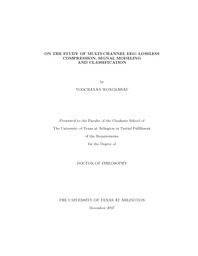
ATTENTION: The works hosted here are being migrated to a new repository that will consolidate resources, improve discoverability, and better show UTA's research impact on the global community. We will update authors as the migration progresses. Please see MavMatrix for more information.
Show simple item record
| dc.contributor.author | Wongsawat, Yodchanan | en_US |
| dc.date.accessioned | 2008-04-22T02:41:29Z | |
| dc.date.available | 2008-04-22T02:41:29Z | |
| dc.date.issued | 2008-04-22T02:41:29Z | |
| dc.date.submitted | December 2007 | en_US |
| dc.identifier.other | DISS-1898 | en_US |
| dc.identifier.uri | http://hdl.handle.net/10106/715 | |
| dc.description.abstract | Recently, electroencephalogram (EEG) has become necessary for diagnosis, telemedicine, and brain computer interface (BCI). This thesis investigates three signal processing tools which can explore multi-channel structures of the EEG for different applications such as lossless compression, artifact removal, and classification.
First, this thesis presents a method for approximating the Karhunen-Loeve transform (KLT) of multi-channel EEG signals. The proposed transform is further parameterized by lifting factorization by which the coefficients' dynamic range is controlled through a proposed pivoting scheme, rendering a reversible structure under quantization of coefficients called IntSKLT. A lossless coder for multi-channel EEG signals which exploits inter-channel correlation among the EEG channels by the IntSKLT is also presented. Simulation results show that the coding performance of the proposed coder is improved by approximately 10% over the benchmark lossless coders. Furthermore, compared with directly using the reversible structure of the KLT (IntKLT), the degradation in coding performance using the IntSKLT is approximately 3% while the computational complexity is reduced by more than 60%.
Second, in order to avoid high computational load on calculating the parallel factor analysis (PARAFAC)-based space-time-frequency model of a multi-channel EEG signal, this thesis presents three reduced complexity space-time-frequency models. The models are developed by dividing the selected contents into segments followed by applying the PARAFAC. By carefully selecting the numbers of segments, signatures extracted from the conventional space-time-frequency model can be approximated by those from the proposed models with the computational complexity reduced by more than 50%. Simulation results show that the proposed models can efficiently extract eyeblink artifacts from background EEG. Furthermore, classification accuracies when employing the proposed models to the BCI application are also comparable with the conventional model.
Finally, this thesis presents a feature extraction scheme called multi-channel flexible local discriminant bases (MF-LDB) for left/right imagery classification of a multi-channel EEG. The MF-LDB is obtained by calculating the local cosine packets (LCP) of the decided channel over nonuniform segments. The proposed method combines information from neighboring channels based on hard and soft decisions. Simulation results show that the proposed feature extraction scheme can improve the classification accuracies of the left/right imagery signals by more than 3%. By applying the minimum variance distortionless response (MVDR) to find the spectra over nonoverlapping segments of each EEG channel, a nonredundant time-frequency transform called local MVDR packets transform which can provide highly selective frequency responses is also presented with approximately 4% improvement in classification accuracy. | en_US |
| dc.description.sponsorship | Oraintara, Soontorn | en_US |
| dc.language.iso | EN | en_US |
| dc.publisher | Electrical Engineering | en_US |
| dc.title | On The Study Of Multi-channel EEG: Lossless Compression, Signal Modeling And Classification | en_US |
| dc.type | Ph.D. | en_US |
| dc.contributor.committeeChair | Oraintara, Soontorn | en_US |
| dc.degree.department | Electrical Engineering | en_US |
| dc.degree.discipline | Electrical Engineering | en_US |
| dc.degree.grantor | University of Texas at Arlington | en_US |
| dc.degree.level | doctoral | en_US |
| dc.degree.name | Ph.D. | en_US |
| dc.identifier.externalLink | https://www.uta.edu/ra/real/editprofile.php?onlyview=1&pid=286 | |
| dc.identifier.externalLinkDescription | Link to Research Profiles | |
Files in this item
- Name:
- umi-uta-1898.pdf
- Size:
- 3.037Mb
- Format:
- PDF
This item appears in the following Collection(s)
Show simple item record


